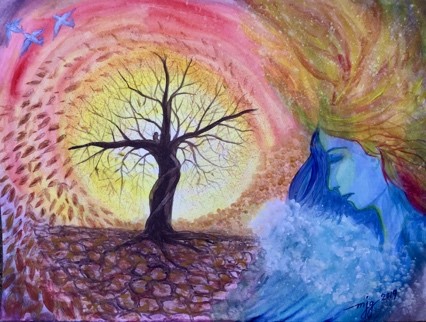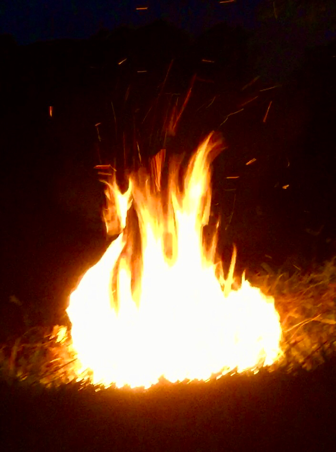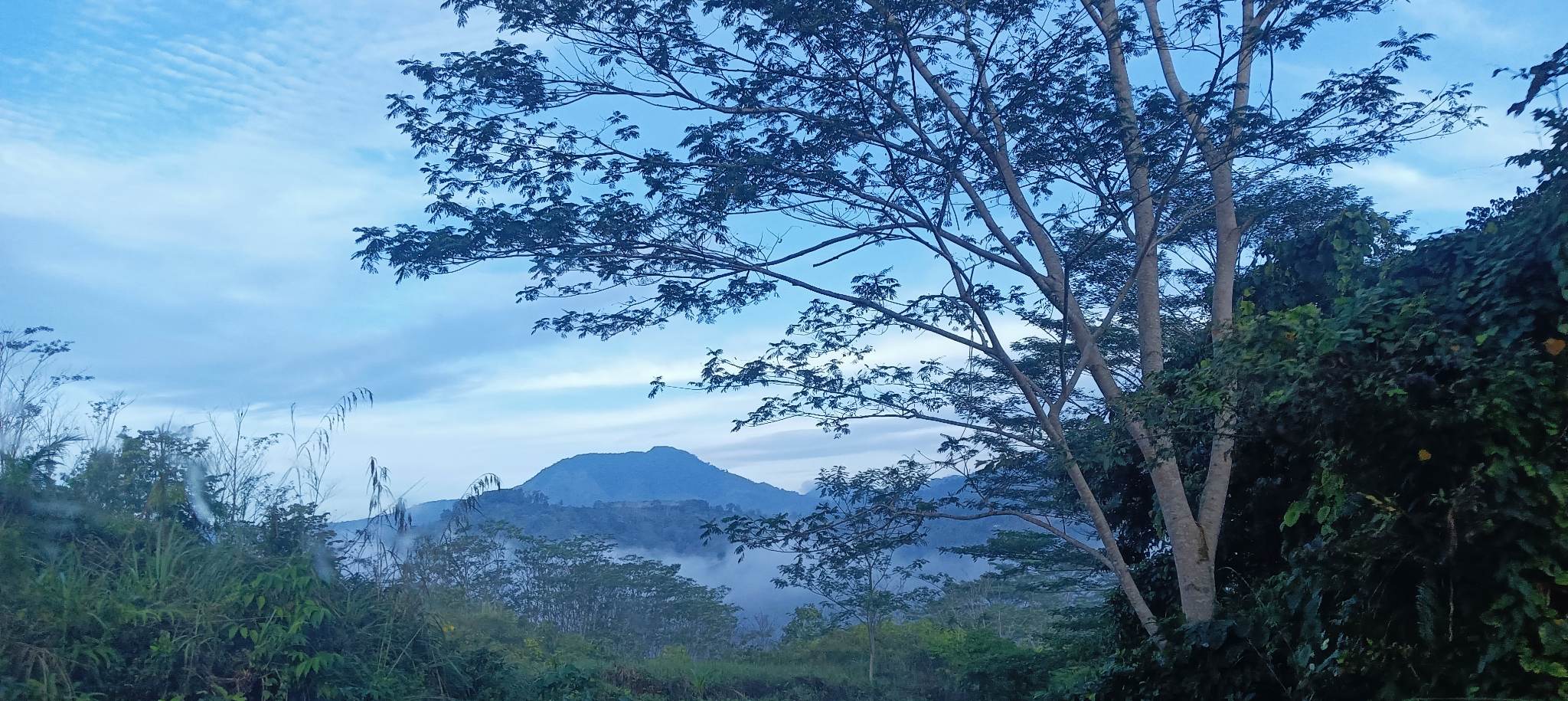“Lord, send out your Spirit, and renew the face of the earth.” Ps. 104:1

Making fire is an ordinary part of the lives of the people in the rural areas which I have taken for granted until I was locked down in this remote area of the country. And so one cold early morning, I was left alone with the seemingly daunting task of cooking breakfast using firewood. Being a city dweller that I am, I must admit that I was in a kind of a panic mode for I had to find a way to ensure that the first spark from the matchstick lighted unto the bits and pieces of dried tree branches and corn cobs would somehow set afire the wooden logs. I had to light a candle in case I would use up all that was left in the matchbox. And so, after several failed attempts of lighting the fire which felt like eternity for me, I began blowing and fanning the black coals every so often so that the dying embers left behind at the kitchen stove would blaze into a good fire ready for cooking. And yes, it was like magic when it suddenly burst into flames that made me shout with childlike joy…”I did it!”

Now after more than two months since I discovered the slow way of cooking with firewood, I have come to appreciate this indispensable element of nature and I am continually fascinated by it specially when it suddenly blazes into a golden fire each time I fan its waning embers. It’s dancing flames mesmerizes my soul for has a way of igniting fire in my belly urging me to capture into words the sparks of wisdom I see bursting forth in the wilderness of my imagination far removed from one’s rational frame of mind. “Someday, after harnessing the winds, the waves, the tides, and gravity, we shall harness for the energies of LOVE, and then for the second time in the history of the world, we will have discovered FIRE.” (Pierre Teilhard de Chardin)
Although electricity has thankfully already reached this place, still the rough and rocky roads makes life difficult for the people living here, majority of whom are indigenous farmers. They use fire for different purposes: to make access through prickly and thick vegetation, to maintain a pattern of vegetation, to encourage new growth and development of useful food plants, for cooking, warmth, signaling and for spiritual reasons. They still resort to controlled burns of low intensity common in forest ecosystems as ways to modify the use of land and are a natural part of nutrient recycling and ecosystem succession for they do not burn a large area of the land contrary to the lamentable continuous cutting and burning of trees by loggers and kaingeros (slash and burn cultivators) that according to the bishops of the Philippines in 1988, have been one of the reasons for the lost of approximately 29 million hectares out of 30 million hectares of primary forest in the country.
A glimpse at the past reveals that what was initially perceived by European colonists as untouched and pristine wilderness in North America were actually the cumulative result of these occasional managed fires creating an intentional mosaic of grasslands and forests across North America sustained and managed by the native Americans. Sadly, the impact of colonization in the 1880s have devastated the indigenous populations with fire exclusion becoming more widespread and by the early 20th century, fire suppression had become an official US federal policy.

However, before the onslaught of COVID-19, the world was aghast with the bushfires that have taken a massive toll in the Amazon and Australian land, wildlife and peoples. Given this alarming reality, the indigenous peoples are our best hope in saving our wildlife and forests for experts in indigenous fire management are reporting an uptick in interest in their work. These ancient technique which involves controlled small fires to moderate larger ones is now seen as having a potential value according to Yvette Cabrera in her article published in Grist dated Jan. 21, 2020.
The so called cultural burning has cut destructive wildfires by forty percent over the last decade and has certainly curbed greenhouse gas emissions in the process. The experiences of indigenous fire experts in Canada and the US however, show that incorporating these techniques into other national and state-led forest service management plans may not be easy because of many factors mainly bureaucratic obstacles and postmodern society’s pervasive fear of fire that dates back during the Colonial era are still very much ingrained in contemporary mindset. Hence, despite the growing support for the use of cultural burns incorporating indigenous approaches on a broader scale, there remains strong resistance blocking its large scale implementation.
And so as the world continues to languish in the dark tunnel of this global pandemic caused by the Coronavirus 19, we turn our hearts to God in all humility asking for His divine grace and mercy: “LORD, will you hide yourself for ever? How long will your anger burn like fire? Remember how short my life is; remember that you created all of us mortal! Who can live and never die? How can human beings keep themselves from the grave?” (Psalms 89:46-48) Fire in this particular psalm is likened to God’s anger that burns furiously and seems to punish the whole world with His seeming absence and total disregard to humanity’s suffering. On the other hand, the hallmark of an indestructible faith must pass through the crucible of fire: “Be glad about this, even though it may now be necessary for you to be sad for a while because of the many kinds of trials you suffer. Their purpose is to prove that your faith is genuine. Even gold, which can be destroyed, is tested by fire; and so your faith, which is much more precious than gold, must also be tested, so that it may endure. Then you will receive praise and glory and honor on the Day when Jesus Christ is revealed.” (1 Peter 1:6-7).
Paul Kingsworth in his enlightening article “The Great Work, Alchemy and Power of Words” describes vividly how written words can cause ripples in the fabric of reality. It is smith work where fire transforms base metal into the magical (or the other extreme: injustice into bloody revenge). But more than smith work, it is alchemy. The popular image of the alchemist is that of a lavishly cloaked man in a medieval laboratory bending over a furnace trying to burn lead into gold. But he believes that alchemy was always as much about the transformation of the soul and the spirit as it was about any changes in the physical plane.
His thoughts on alchemy as a religious path whereby one goes through a process of transformation, discipline and purification similar to that practiced by the mystics of the most spiritual and religious traditions are groundbreaking as far as my finite mind goes for it summons me to believe time and again that faith above anything else more than reason is what would lead the seeker to attain true knowledge and wisdom of the mind and heart of God. And so, I realized that my fascination in seeing how fire blazes each time I blow the waning charred firewood whenever I cook has actually awakened my eyes to see life in a profoundly different way.
This reminds me of the two disciples on the road to Emmaus who both had a life changing encounter with the risen Lord that made them say to each other: “Wasn’t it like a fire burning in us when he talked to us on the road and explained the Scriptures to us?” (Lk. 24:32). So too, I am convinced that nothing as precious as gold tried by fire is attained through cheap grace, that is, nothing of eternal value comes easy and instantly. We need to be patient in the process without giving up during these most difficult and trying times in this juncture of our life’s journey for we Christians are an Easter people.

The Paschal Candle lit on the eve of Holy Saturday to symbolize the resurrection of our Lord Jesus must remain lighted in our hearts all throughout the days of our lives reminding us of this vital truth of who we are along with the urgent mandate given to us by the Lord: “I have made you a light so that my salvation may reach the remotest parts of the earth.” (Acts 13:47) Likewise, there is also an ancient meaning to the Easter fires that dates back to the pre-Christian Saxon tradition. The people make bonfires as a way of helping the Earth to usher in Spring and dispel the cold and dark of Winter. The fires were also seen as a symbol of fertility and rebirth. The ashes from the Easter fires were spread on the field to fertilize the soil and to ensure an abundance of good crops for the coming year.

Teilhard de Chardin wrote the following: “In the beginning was Power, intelligent, loving, energizing. In the beginning was the Word, supremely capable of mastering and moulding whatever might come into being in the world of matter. In the beginning there were not coldness and darkness: there was the Fire. This is the truth. So, far from light emerging gradually out of the womb of our darkness, it is the Light, existing before all else was made which, patiently, surely, eliminates our darkness. As for us creatures, of ourselves we are but emptiness and obscurity. But you, my God, are the inmost depths, the stability of that eternal milieu, without duration or space, in which our cosmos emerges gradually into being and grows gradually to its final completeness, as it loses those boundaries which to our eyes seem so immense. Everything is being; everywhere there is being and nothing but being, save in the fragmentation of creatures and the clash of their atoms.”
Pentecost marks the culmination of Christ’s death and resurrection (Paschal Triduum). It is the birth of the Church. Jesus kept his promise to his disciples that he would send them the Holy Spirit: “Peace be with you! As the Father has sent me so I send you. After saying this, he breathed on them, and said to them, “Receive the Holy Spirit,…” (Jn. 20:23). The coming of the Holy Spirit upon the apostles happened in an unimaginable way in the form of tongues of fire that came to rest on each of them sending them into the whole world to preach the Good News of our salvation and to baptize. “When the day of Pentecost came, all the believers were gathered together in one place. Suddenly there was a noise from the sky which sounded like a strong wind blowing, and it filled the whole house where they were sitting. Then they saw what looked like tongues of fire which spread out and touched each person there. They were all filled with the Holy Spirit and began to talk in other languages, as the Spirit enabled them to speak.” (Acts 2:1-4)
From then on, their lives were never the same again for it radically catapulted them into men and women on fire with the love of God so much so that they were filled with astounding courage and extraordinary audacity to preach the Good News in every nook and corner of the world. They were indefatigable in their zeal and passion even to the point of death and martyrdom for the sake of the Gospel. “Anyone who is joined to Christ is a new being; the old is gone, the new has come.” (2 Corinthians 5:17)
Today, more than two thousand years after Pentecost, this very same fire continues to burn brightly amidst the terrible winds blowing fiercely threatening the Church to plunge into the darkness of death and despair. Nevertheless, let us firmly believe that we shall prevail as we beg the Blazing Spirit to breathe upon the flickering embers of our faith so that we may also become new persons capable of fanning the flames of new life, sparks of hope and light that even the smallest of our actions can create amazing wonders for the life of the world.

A PRAYER
Lord, hold me close to the inmost depths of your heart;
and then with your gentle flame of love,
that only the power of the Holy Spirit can give,
purify me, transform me and set me on fire,
until I become utterly what you would have me be…
A beacon of light blazing in the world’s darkness,
Living life to the full with concrete actions,
Serving others with genuine compassion,
Proclaiming your salvation
To all the ends of the earth.
Amen.
Marjorie J. Guingona, SAC
May 25, 2020
Nanga-Nangan, Tigbao,
Zamboanga del Sur










